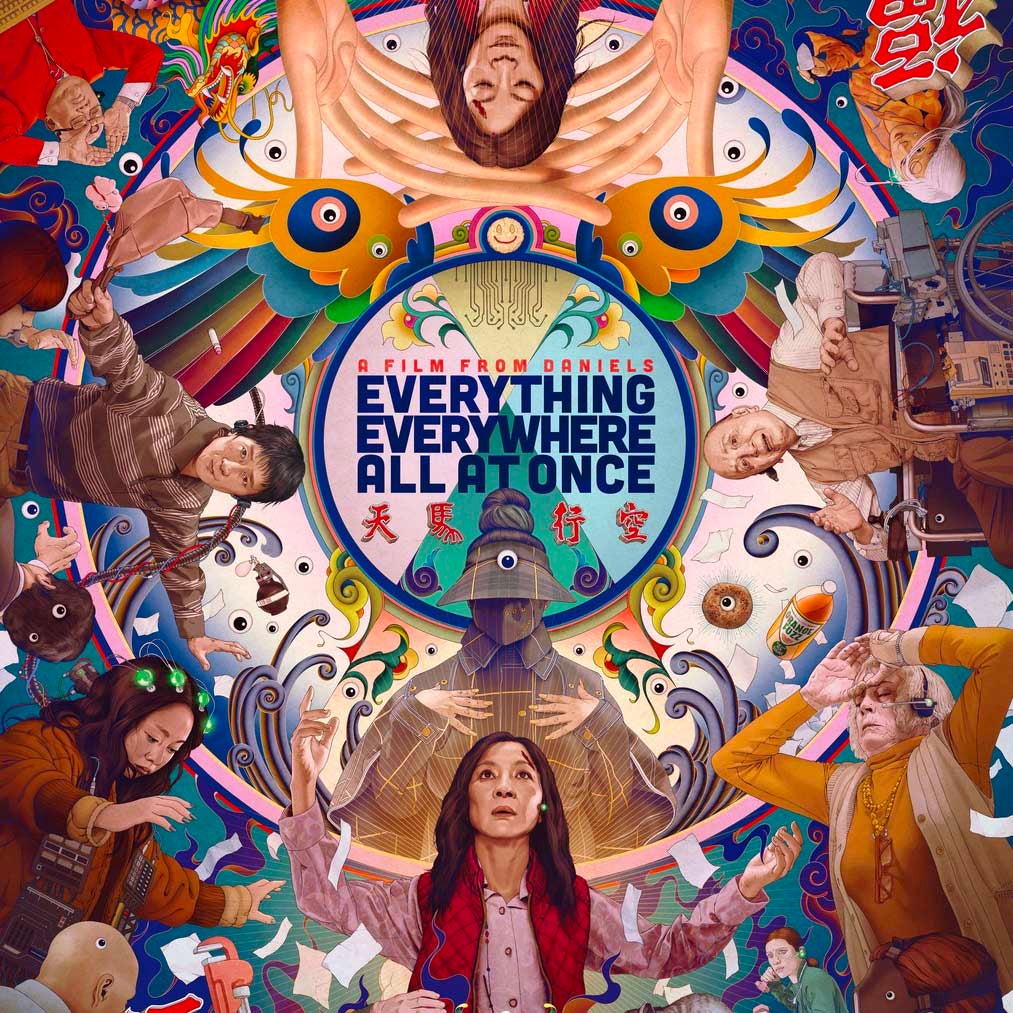
(Nora Sullivan Horner)
Female Asian Empowerment, Powerlessness, and Dimension-Hopping in Everything Everywhere All at Once
This past Saturday, I went with some friends to see Everything Everywhere All at Once at the Eveningstar Cinema here in Brunswick. The 2022 film was written and directed by Daniel Kwan and Daniel Scheinert and features Michelle Yeoh, Stephanie Hsu, Ke Huy Quan, Jenny Slate, Harry Shum Jr., James Hong, and Jamie Lee Curtis. The film is charming, touching, and cosmically, comically absurd about the nature of existence(s) itself. It follows a Chinese-American woman who runs a laundry business with her family, struggles to file her taxes, remains unaware that her husband is about to serve her divorce papers, scrambles to organize the local Chinese New Years celebration, pacify her belligerent semi-estranged father, walk the wobbling tightrope of a relationship with her daughter, all while trying to save the very fabric of the multiverse in her spare time. To “jump” multiverses, the wearer dons a dorky-looking twin-Bluetooth-earpiece set-up and performs profoundly random actions (such as switching left and right shoes, slicing paper cuts between your fingers, or breaking out into Swiss yodeling) that increase the probability of leading to an alternate universe, slingshotting the wearer’s consciousness to that version of reality and downloading the skills of that alternate version into the starting universe in real-time. Thus, the wearer immediately can tap into and harness the hibachi knife-wielding, Kung fu-kicking, or sausage-finger-having characteristics of alternate versions of themself. Of course, all this consciousness-dimension jay-walking places a huge strain on the wearer’s psyche. In order to withstand physically and mentally inhabiting more than one reality at a time, the jumper must have incredible mental fortitude either gotten through sheer luck or rigorous training. What happens when the human mind is pushed beyond the breaking point? And reality itself breaks with it? What would happen if a person could jump to different times, places, and realities at will—their metaphorical hands and fingers in every possible cookie jar and pie in the universal bakery?
These are just one half of the questions that this film attempts to answer. The others are of even more significance, if you can believe it. How do you express your love for those you share your life with when you feel your life is subideal? When you find yourself wondering and wishing what would’ve happened had you not made that fateful decision to move countries, start a business, marry your partner, or have children at all? How do you grapple with the concerted forces of poverty, racism, sexism, and bureaucracy? How do you care for a parent who rejected you and how do you love your daughter who’s so different from you without rejecting her in turn?
I highly recommend this film. It’s witty and self-aware, serious and silly oftentimes in the same breath. It references many tropes of Asian-Americans in mainstream media—cue dramatized Kung fu fight scenes accompanied by exotic “oriental” music—in a smart 21st century kind of way. Though, while I was able to appreciate the tongue-in-cheek sass of the film, I felt uncomfortable sitting in a theater with predominantly senior white individuals who were laughing out loud during these very scenes. It made me question what was really funny to them—the ironic playing of the stereotyping of Asian characters in film or the stereotypes alone? Still, the story stood on its own two feet. It examined the common familial dynamics of first-generation parents and second-generation children, especially those of ethnic minorities occupying the lower-middle class. It explored the role of gender and sexuality, the role of generational differences and misunderstandings, the power structure of the heteronormative family. I enjoyed seeing a Chinese-American woman take center stage(s) throughout the film; I enjoyed peering into her mind and her reflections on her life choices, her assessment of the present, and daydreaming of possible futures that are closer to her than she could have ever dreamed of. I cheered when she took power of her destiny, choosing the road less and more traveled, and I mourned when it was wrenched from her hands at other times. Ultimately, the film asks the big question: How do you find contentment in the one imperfect present you inhabit—and make peace with all those other realities you don’t?
These questions of the heart and spirit is what places the film on the soft SF-side of the spectrum. The “tech,” while instrumental in the plot, is not at its center; it’s the people, it’s their relationships. It’s time and place and its irreversibility and irreplaceability. It’s the fleeting, it’s the futile, it’s the confusing. It’s everything everywhere all at once. –Nora Sullivan Horner
